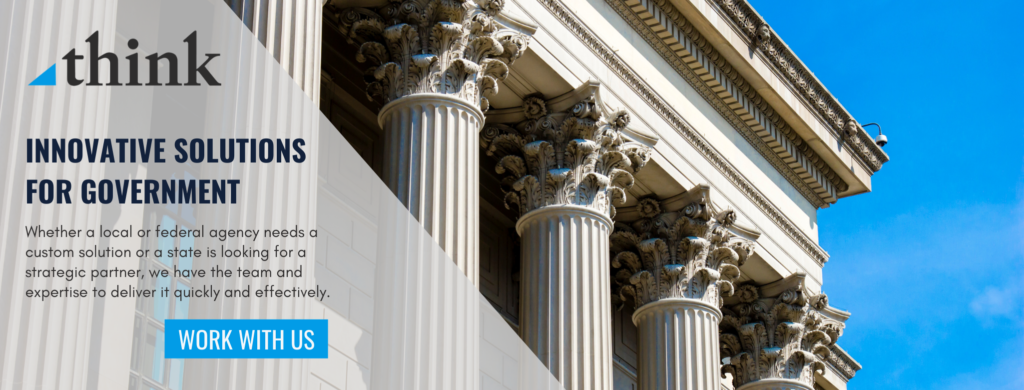Human Centered Design: Improving Customer Experience in Government

Nearly every business has had to substantially change the ways they serve their customers as a result of the pandemic, from restaurants setting up new outdoor dining areas to office-bound enterprises deploying new technology to stay in touch remotely.
Now consider for a moment the changes you’d have to make if your customer base included every single American. This was the situation in which many government agencies found themselves, with unprecedented demand for online access coupled with countless new programs designed to address the financial effects of the pandemic. The results, both present and future, offer some lessons for all organizations, public or private.
The Challenges in Government Customer Experience
The typical disconnect here is that while government by definition exists to serve the people, the people in general will often go to great lengths to avoid dealing with government agencies. We’ve all heard more than our share of anecdotal evidence to this end, from vacation days wasted dealing with issues at the state DMV to long hold times in advance of customer service that’s indifferent at best.
Then in March of 2020 the pandemic hit with full force. More citizens than ever needed government services, further stressing systems that were in many cases already strained. The tales of businesses trying to get straight answers about the PPP loans they needed to stay in existence were many, as were the struggles of those attempting to secure unemployment benefits or other pandemic-related support.
In many cases, especially at the federal level, agency leadership recognized these issues and addressed them head-on. There was more than one strategy, of course, but at the heart of many of the solutions was human centered design.
Human Centered Design
Human centered design (HCD) at its core puts the needs of people first. That sounds like a disarmingly simple concept, and it is, but it’s also far less common than most of us would like. We’ve all experienced the wildly unintuitive website of a government agency, or the encounter with a bureaucrat so mired in pages of regulations and legalese that they seem to have forgotten that their role is to serve us.
Human centered design goes well beyond a more logical website structure, although that’s a part of the picture. It’s an overall shift in thinking, away from a strictly transaction-based experience and towards relationship building. A post on Govloop.com breaks HCD down into four components, each of which offers some lessons for the private sector also:
Communication-level.
This is part of the ‘how’ in getting information to the user. Mobile-friendly websites, text-messaging services, social media … HCD begins with meeting consumer where they are.
Product-level.
This might be a revamp of any number of overly complex government forms, or even an app that streamlines a particular process.
Interaction-level.
As the name would imply, interaction-level HCD is about the customer service experience. One crucial part of reducing the siloing that government agencies are known for, which leads to the “that’s not my department” mindset so frustrating to consumers.
System-level.
This is the big-picture view of HCD, and it involves addressing the organizational culture and the mindset around how customers are treated throughout their journey.
How HCD is Working in Government
Everyone loves to hate the Internal Revenue Service, but few organizations had to pivot more, or faster, when the pandemic hit. Faced with sudden demand for assistance with economic impact payments, child care credits and more, the agency accelerated its plans and changed priorities, leading with HCD.
Visit irs.gov today and right near the top of the home page you’ll find a “How can we help you?” headline followed by nine prominent links that between them would appear to address most of the major reasons a taxpayer would visit the site. Just a bit further down the page are links to tools and apps addressing everything from identity protection to a mobile app offering free tax help, refund status and more. That’s just one example of many digital innovations being embraced by the IRS as part of the Taxpayer First Act, a name with its roots in HCD.
On an even wider (system-level) scale, the General Services Administration (GSA) recently launched a new project called the Benefits Eligibility Awareness Resource Service (BEARS). The concept is simple but the execution is not: The goal of BEARS is to create a cross-agency tool so that a user can go to a single portal to understand their benefits eligibility across a variety of government agencies, perhaps the ultimate example of eliminating silos. BEARS is still in its preliminary stages, but if it comes to fruition will stand as testament to the concept of human centered design.
Fail Fast
By their very nature, these are some daunting changes to make, with plenty of ways for things to go wrong and great deal at stake. In most cases these solutions are being rolled out on an iterative basis, with smaller test runs to make sure not only that the solution is correct but that the problem is really the one that needs addressing. The GSA’s Nico Papafil notes the “fail fast, fail forward, fail small” approach, saying, “Taking that user-centered approach, being agile, being lean, allows us to fail small and really move more promising projects forward for the right solution.”
There’s much more to HCD from a government standpoint, from accessibility in multiple languages to the constantly increasing need for data security, and there’s still much to be done. There’s been real progress in many quarters, however, towards a more streamlined and less frustrating consumer experience, a worthy goal for any enterprise.
